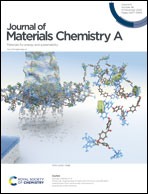Low-cost valence-rich copper–iron–sulfur–oxygen porous nanocluster that drives an exceptional energy-saving carbohydrazide oxidization reaction in alkali and near-neutral electrolytes†
Abstract
Significantly reducing the anodic oxidization reaction potential is very important for realizing highly efficient, energy-saving hydrogen production. In this paper, we introduce for the first time an environmentally friendly and exceptional energy-saving carbohydrazide oxidization reaction (COR) catalysis system as an anode. In this system, a robust, low-cost and valence-rich copper–iron–sulfur–oxygen porous nanocluster (Cu–Fe–S–O PN) catalyst was fabricated using a one-step mild wet chemical bath synthesis (CBS) method. Combining this catalyst and the carbohydrazide-containing electrolyte, we obtained the lowest anodic oxidization potentials ever obtained, of 0.45 V (vs. RHE) and 1.01 V (vs. RHE) for driving 10 mA cm−2 current density in alkali or near-neutral electrolyte, respectively. These values surpass all those of previously reported environmentally friendly alkali energy-saving electrolysis systems, even neutral or near-neutral electrolysis systems, to the best of our knowledge.



 Please wait while we load your content...
Please wait while we load your content...